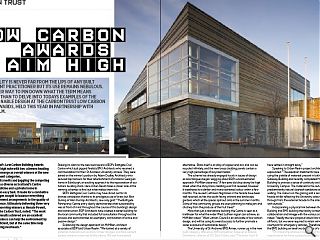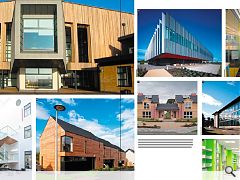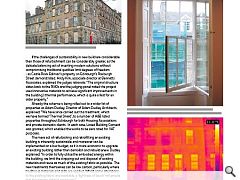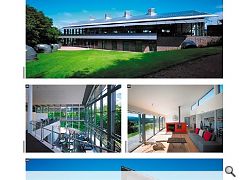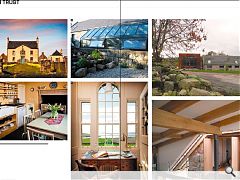Low Carbon Building Awards
24 Apr 2012
The word sustainability is never far from the lips of any built environment practitioner but its meaning remains nebulous. What better way to give the term definition therefore than to delve into todays examples of the best sustainable design at the Carbon Trust Low Carbon Building Awards, held this year in partnership with Urban Realm.
Each scheme had its merits and juggling the competing qualities of entrants as diverse as Scotland’s Centre for Regenerative Medicine and a private home in Aberdeenshire was no easy task. It made for a combative afternoon as our judges sought to balance everything from project management arrangements to the quality of the occupant experience. Ultimately delivering three very different and very deserving winners as Renate Powell, project manager at the Carbon Trust, noted: “The work undertaken and the results achieved are an excellent example of how a business can help the environment by becoming energy efficient, but at the same time help themselves by reducing overheads.” Staking its claim to the new build award is BDPs Bathgate Civic Centre which just pipped finalists BMJ Architects who received a commendation for their St Andrews University annexe. They were joined on the winner’s podium by Adam Dudley Architects who secured top honours for their refurbishment of a historic Georgian home in Edinburgh, an exciting approach to the rejuvenation of our historic building stock. Here Urban Realm takes a closer look at the winning schemes to find out what makes them tick.
BDPs Bathgate Civic Centre may have stood out for its bronze complexion thanks to its prodigious use of brass but Alan Dunlop of Alan Dunlop Architects, saw only gold: “The Bathgate Partnership Centre entry clearly demonstrates that sustainability was at front of mind throughout the course of this building’s design and construction. BDP Architects have created a better building for the local community that included full consultation throughout the process and demonstrates an exemplary combination of active and passive design.”
Explaining the design approach Ian McMillan, architect associate at BDP told Urban Realm: “We looked at a variety of potential materials such as brick, timber shingles, and fibre cement panels; however brass met all the criteria. We had investigated other metal alloys such as zinc, copper, bronze and even gold which also had potential, however the brass does have a certain gravitas in the way it turns to a bronze-like colour, and was an affordable alternative. Brass itself is an alloy of copper and zinc and can be recycled infinitely, and the new brass cladding panels contain a very high percentage of recycled metals.”
The scheme has already engaged locals in issues of design as local tongues began wagging about BDPs unconventional approach. McMillan observed: “A few jaws did drop along the high street when the shiny brass cladding was first revealed, however it weathered to a darker and more restrained colour within a few months. The reused Caithness flagstones in the facade have been well received, as has the south facing orchard and landscape gardens which all the spaces spill out onto in the summer months. Some of the community groups are even planning to make jam and chutney from the produce of the fruit trees!”
More than just a standalone building the Centre is seen as a trailblazer for what the wider West Lothian region can achieve, as McMillan noted: “West Lothian Council is an advocate of low carbon design, and will be using its award success to further promote a wider exposure of sustainable design.“
The University of St Andrews BMS Annex, runner up in the new build category, offered up stiff competition however as Branka Dimitrijevic, director of CIC Start Online, said: “The entry from St Andrew’s University for the BMS Annex demonstrated a high level of low carbon design and good internal elements, all executed with the upmost attention to detail. The occupants love this building and have settled in straight away.”
Speaking to Urban Realm project architect Yvonne Roddie, expounded: “The elevation treatments have been developed using the palette of materials present in both the existing Gateway Building and recently completed Medical Sciences Building to provide a sense of continuity and cohesion within the University Campus. The materials to the outward elevations are predominantly natural clashach sandstone and glazed curtain walling. The colours on the glazing add a sense of rhythm to the facade whilst reflecting the University colours which are carried through from the external facade to the interiors, connecting inside with outside.”
Incorporating a physical link between the existing Purdie Building and BMS building the facility is intended to foster collaboration and linkage with the various sciences within. Roddie noted: “Ideally the new proposal would link to both buildings on all floors, but we were required to retain vehicular access to the courtyard for emergency vehicles. Therefore we proposed to link the BMS building on level two by means of a glazed bridge.
“Of critical importance in buildings of this type are the requirements for fume cupboard and safety cabinet exhausts. To avoid exposing this number of stacks individually these exhausts were collected in one single duct enclosure terminating above roof level.”
If the challenges of sustainability in new build are considerable then those of refurbishment can be considerably greater, as the delicate balancing act of inserting modern solutions without compromising traditional qualities limit degrees of freedom - as Castle Rock Edinvar’s property on Edinburgh’s Roxburgh Street demonstrated. Andy Kirk, associate director at Bennetts Associates, explained the judges rationale: “The original structure dates back to the 1840s and the judging panel noted the project used innovative materials to achieve significant improvements in the building’s thermal performance, which is quite a feat for an older property.”
Already the scheme is being rolled out to a wider list of properties as Adam Dudley, Director of Adam Dudley Architects, explained: “We have since carried out this treatment, which we have termed ‘Thermal Shield’, to a number of A&B listed properties throughout Edinburgh for both Housing Associations and private domestic clients. In each case, Listed Building Consent was granted, which enabled the works to be zero rated for VAT purposes.
The mere act of refurbishing and retrofitting an existing building is inherently sustainable and moreover can be implemented on a low budget, as it is more economic to upgrade an existing building rather than demolish and rebuild anew. Dudley explained: “In order to fully utilise the embodied energy within the building, we limit the stripping out and disposal of existing materials and reuse as much of the existing fabric as possible. The new treatments themselves can be low carbon, particularly where traditional materials and skills are applied. Whilst some alterations to the existing fabric are inevitable, a ‘lightness of touch’ will ensure that the historic detail is preserved.”
Outlining some of the techniques required to successfully insert modern solutions without compromising on traditional quality Dudley continued: “A sound understanding of the existing building fabric is required, together with research to test the impact of each intervention on the dynamics of the building. All treatments have to be carefully designed so as not to adversely affect the functionality, aesthetics and performance of the building. Where possible, architectural features and finishes should remain unaltered and all interventions should be barely discernible, and also be reversible.
“The project would have benefitted from a more thorough briefing for the occupants, to prepare them for the inevitable disruption to their daily routines during the course of the works. Where the treatment was carried out to all of the walls at one time, it proved to be overly disruptive, and in future it would be preferable to divide the works into two phases, leaving part of the property undisturbed.”
Roger Curtis, technical research manager at Historic Scotland, who oversaw the work, added: “In this pilot some measures were expensive, but demonstrated what is possible – in places the costs can be reduced by increasing scale and adjusting specification as the market matures.”
That such diverse and effective low energy responses are being adopted across all levels of construction throughout Scotland bodes well for the industries future. These projects demonstrate that large or small, public or residential, big budget or not, low carbon principles can and should lie at the fore of all that we do.
|
|
Read next: Awards or Rewards?
Read previous: Linwood
Back to April 2012
Browse Features Archive
Search
News
For more news from the industry visit our News section.
Features & Reports
For more information from the industry visit our Features & Reports section.


